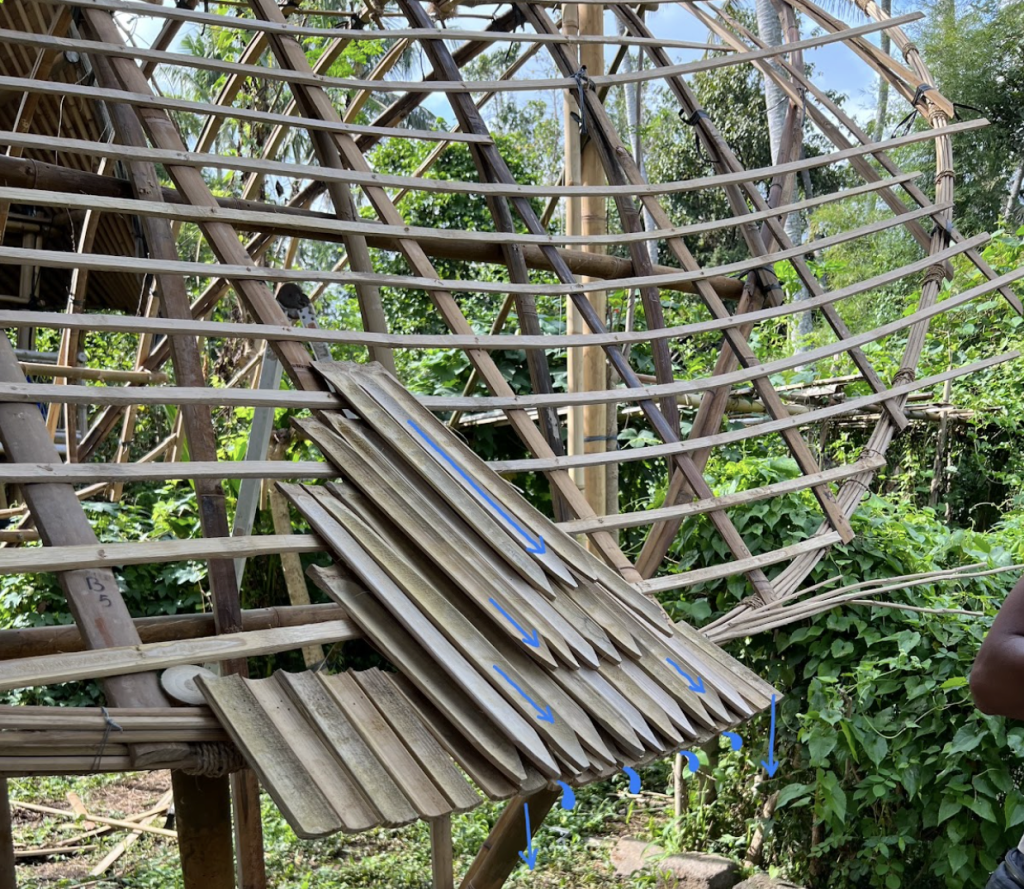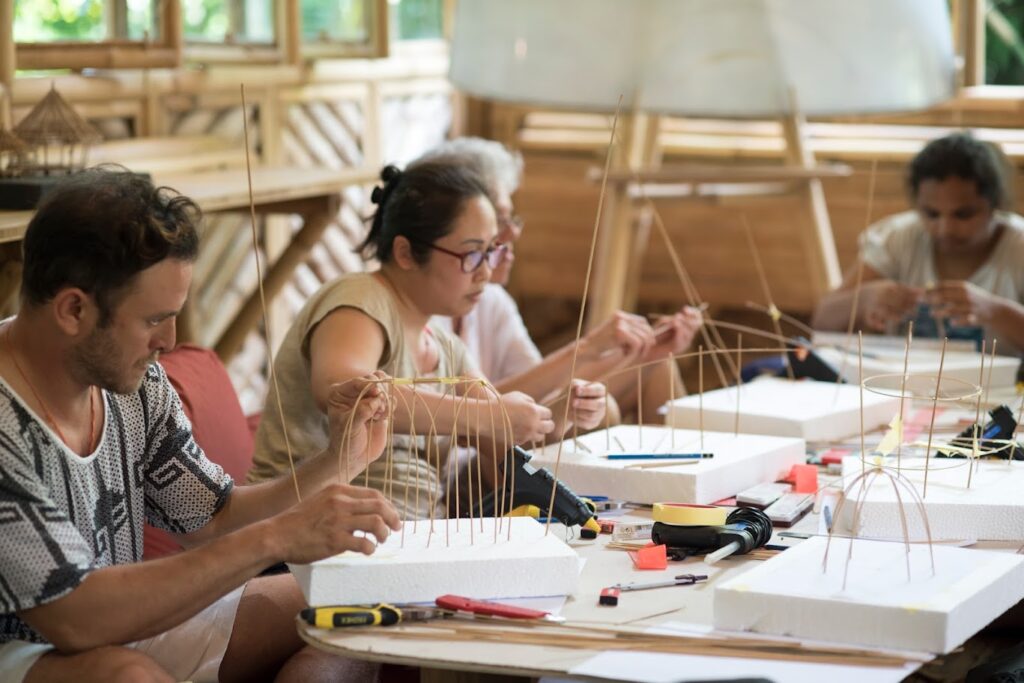Innovations In Traditional Sirap Roofing: Building With Bamboo Splits
By Mia Larsen | June 27, 2023 | Construction -

Learn about Sirap, the Indonesian bamboo split roofing, for curvilinear, nature-inspired roof designs.
Rooted in Balinese tradition, Sirap roofing, also known as bamboo shingles, involves carving a shingle from bamboo splits. Its compatibility with curvilinear roof designs and inherent natural appeal underscores the advantages of this method.
Boasting a rich history within Indonesian communities, Sirap roofing - both bamboo and timber variants - is a testament to local craftsmanship and sustainable construction techniques. This article explores the art of building a bamboo roof using bamboo splits, discussing the pros and cons of Sirap roofing, necessary considerations for its implementation, and where this traditional Indonesian technique truly excels.
In Indonesia, Sirap roofing, including both bamboo and timber variants, has a rich and enduring history that spans centuries, particularly in regions like Bali and Java. What makes Sirap roofing remarkable is that it unintentionally embodies sustainable principles, reflecting the deep cultural values of Indonesian communities. While the Balinese craftsmen may not have originally planned for its sustainable qualities, Sirap roofing stands the test of time and continues to be appreciated for its natural aesthetics, functional benefits, and its inherent sustainability.
Now that we've traced the historical and cultural footprint of Sirap roofing, let's delve into the practical aspects of this method. In this article, we cover:
- Pros of Sirap Bamboo Roofing
- Cons of Sirap Bamboo Roofing
- Implementation Of Sirap Bamboo Roofing

Pros of Sirap Roofing
- Ideal for Curvilinear Roofs: Sirap shingles are made by cutting bamboo splits into small pieces. The ability to arrange them side by side makes Sirap an excellent choice for curvilinear roof designs. Sirap allows for the creation of complex roof shapes, enabling architects to express their creativity and achieve visually stunning results.
- A Natural Roofing Solution: Bamboo, being a natural material, offers inherent sustainability and eco-friendliness. By utilizing bamboo shingles, architects and homeowners can embrace a roofing solution that aligns with environmentally conscious principles and reduces reliance on non-renewable resources.
- Biomimicry-Friendly: A key advantage of Sirap roofing lies in its capacity for biomimicry. The way the shingles are assembled and overlaid can mimic the skin of a snake or other patterns found in nature, offering an aesthetically pleasing and biologically inspired design element.
Cons of Sirap Roofing
- Limited Lifespan: One notable drawback of bamboo shingles is their relatively short lifespan. Due to natural weathering and the effects of exposure to the elements, the shingles may need to be replaced every 5-10 years to maintain their functionality and appearance. Regular inspections and maintenance are essential to identify any deteriorating sections promptly.
- Labor-Intensive Process: Constructing and installing bamboo shingles requires significant labor. Each shingle needs to be carefully crafted and attached to horizontal battens, which demands skilled craftsmanship and attention to detail. The intricate installation process contributes to higher labor costs and longer construction timelines compared to other roofing materials.

Implementation of Sirap Bamboo Roofing
During the assembly, bamboo shingles are positioned upside down, with the convex side facing upwards. This orientation prevents water from flowing sideways and creating weak spots that could lead to leaks over time. Instead, the shingles function as natural conduits, directing water flow downward and ensuring effective drainage.
It is crucial to account for the weight of bamboo shingles during the design phase. The underlying structure must be appropriately engineered to bear the load. Careful consideration of structural requirements, such as support beams and rafters, is necessary to ensure the long-term stability and integrity of the roof.


In conclusion, the Sirap roofing technique, utilizing bamboo splits as shingles, presents architects and homeowners with an appealing option for achieving intricate, curvilinear roof designs while embracing sustainability.

In real-life applications, Sirap roofing has proven it is worth time and time again. A prime example can be found right here at Bamboo U, in our Coconut Shack, built during the November 2022 course. The structure perfectly encapsulates the potential of Sirap roofing. The curvilinear design of the roof was made possible through the arrangement of the narrow bamboo shingles, demonstrating the ability to create complex shapes and forms. The shack’s aesthetic appeal, enhanced by the unique, nature-mimicking pattern of the shingles, embodies the sustainable construction principles that Sirap roofing exemplifies.
Ready to delve deeper into the world of sustainable construction? Explore Bamboo U's online and in-person programs here https://www.bamboou.com/courses

Mia is an architectural designer from Australia with hands-on experience in bamboo building. Her passion for design, fueled by a deep desire for sustainable solutions, led her to join the Bamboo U team as a Student Visitor from March-August 2023 and as a content writer from 2025.
JUNE 13-24, 2025
The 11 Day Bamboo Build & Design Course in Bali
In 11 days, we'll show you how to build bamboo structures we’ll share all that it takes to build with nature.
Start Anytime
The Bamboo Harvesting Course
The Bamboo Harvesting Course is an online step-by-step training to harvest and care for your bamboo clumps to ensure their longevity and productivity. This maximizes the potential of this beautiful grass as a rapidly renewable resource.Whether you are an architect, builder, or sustainability enthusiast, this mini course will enable you to utilize this rapidly regenerative resource as a durable construction material.It will help remove any fear or doubt about the durability of bamboo and help you build reputable bamboo structures that stand the test of time!
















